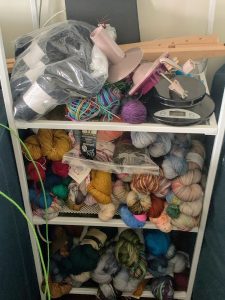By Melissa Mintern

My stash is out of control.
Since the beginning of COVID, I have felt the need to purchase yarn from all my favorite yarn stores and indie dyers to support small businesses during these really hard times. I have out purchased my knitting speed and now my tiny home is overrun.
The significant other, while infinitely patient, is wondering where all this yarn is supposed to live. I used to have a system, but between working from home and never leaving my home, the system has become a bit more flexible, so we need to start at the beginning.
Since my stash is also insured, I’ve lost the value of what’s here and need to update my insurance policy.
How would you handle this? What organization methods have worked for you? I’m going to take the upcoming long weekend to get my hands around the stash and to bend it to my will.
Here is my plan:

I will gather all the yarn into one space. I loosely have yarn currently stored in three categories: sweater stash, sock stash, and miscellaneous stash. I admittedly haven’t done a great job sorting my stash in the last two years, which makes this step pretty important. With all the yarn gathered in one space, I want to reacquaint myself with what I have. I will handle and match every skein with any of its siblings. This is also a wonderful opportunity to check thoroughly for signs of pests.
When purchasing yarn, I lean towards buying for specific projects. If the project is still enticing for that yarn, those labels will be marked with the pattern name. Label marking examples: There are 7 skeins of the same yarn in different colors purchased for a pair of color work mittens. Labels will be marked 1 of 7, 2 of 7, etc and the pattern name Logan. Example 2: I buy NFC studio DK in Oliver whenever there is a sale. It’s a favorite for quick last minute baby knits. So all those will be labeled 1 of 4, 2 of 4, etc. with no pattern name. Anything that no longer fits into my knitting life will be donated to the Guild.
Once everything has been matched, labeled and checked for pests, I need to decide on organization. When it was still organized, the previous categories worked fairly well for me. Sweater stash (7 skeins or more of a matching yarn) in one space, sock stash in another and miscellaneous stash in another. In addition, I might create a queue stash. So maybe the next 5 projects I want to make will go in a visible area to keep my imagination engaged. Currently the sweater stash is in one large vacuum storage bag like Space Savers. The sock yarn is laid out on shelves that are visible at any time. Miscellaneous stash is in containers under my bed. Optimally, all stash would be contained to those 3 areas. Send leftover yarn to the Guild.

Now that all the yarn has been organized, let’s talk about your investment and how to make sure it’s protected. So in fairly basic terms, all your craft items are covered by your homeowner’s or renter’s insurance under personal property (for condos your master condo policy will not cover personal property and you need a walls-in policy). Your policy has a limit, usually $5,000 for ALL your personal property. Your policy also has either a replacement cost or a what-you-paid limitation as well.
Let’s say I paid (these are imaginary round easy numbers) $1000 for the stash, but the retail value of the stash is $1500. If my policy is a replacement cost, the insurance company would pay me $1500. If my policy only covers my cost, they pay me $1000.
This goes for everything. That spinning wheel you found on FaceBook Marketplace for a steal? You paid $100 but you could never replace it for that cost. Check your policy. What is your personal property limit? $2000? $5000? Is it enough? Most companies will say you need a special rider for jewelry, but anything of value probably needs a rider, including your stash. Insurance companies won’t ask you about the $5000 investment in knitting.
Instead of doing intense math I estimated $20 per skein and I used that to discuss with my insurance agent. My agent laughed at me when I told them the replacement cost of the wool in my home but in the end we did need to make an adjustment to my policy. Photos are important documentation if you ever need to file a claim. If your stash is photo’d and uploaded to Ravelry, you’re ahead of the game here.
Once all the stash is categorized, planned out and insured, I shall sit back and enjoy my organized stash for 5 minutes. And then I’ll probably go order more yarn.








 After growing up in the city and suburbs, the owners of Get Bentz Farm felt a need to be closer to nature and to be more connected to where their food came from.
After growing up in the city and suburbs, the owners of Get Bentz Farm felt a need to be closer to nature and to be more connected to where their food came from. 










